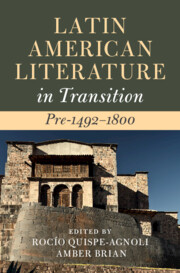Book contents
- Latin American Literature in Transition Pre-1492–1800
- Latin American Literature in Transition
- Latin American Literature in Transition Pre-1492–1800
- Copyright page
- Dedication
- Contents
- Figures
- Contributors
- Acknowledgments
- Introduction Dwelling in Transitions
- Part I Land, Space, Territory
- Part II Body
- Part III Belief Systems
- Part IV Literacies
- Part V Languages
- Part VI Identities
- Index
- References
Introduction - Dwelling in Transitions
Published online by Cambridge University Press: 25 November 2022
- Latin American Literature in Transition Pre-1492–1800
- Latin American Literature in Transition
- Latin American Literature in Transition Pre-1492–1800
- Copyright page
- Dedication
- Contents
- Figures
- Contributors
- Acknowledgments
- Introduction Dwelling in Transitions
- Part I Land, Space, Territory
- Part II Body
- Part III Belief Systems
- Part IV Literacies
- Part V Languages
- Part VI Identities
- Index
- References
Summary
This chapter introduces the volume by offering a reflection on the notion of transition within and across Latin American literary production from 1492 to 1800. This period is defined by a series of transitions as, motivated by personal ambitions or brought by force, Europeans and later Africans and Asians crossed oceans to inhabit the already inhabited lands of the Indies. Native societies and the emergent European colonial societies were transformed by these interactions and the processes that underlay them. This introductory essay explores the broad historical context for this period of transition as it was registered on local and global scales. The book is organized around six thematic areas, which in turn are introduced.
Keywords
- Type
- Chapter
- Information
- Publisher: Cambridge University PressPrint publication year: 2022



